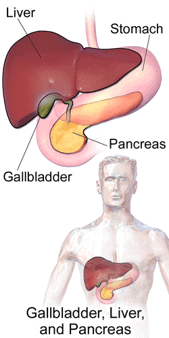The Healthy Liver
We all need a healthy liver to live – it’s so essential that “live” is in the name!
Where to Find Your Liver
The liver is your body’s largest internal organ, weighing between 3 and 5 pounds. Your liver is located on the right side of your upper body, below the lungs, taking up most of the space in your rib cage. The gallbladder, which stores bile made in the liver, is found tucked under your liver. Your liver is made up of two separate sections, or lobes: the larger right lobe and the smaller left lobe. These two lobes are separated by tissue which anchors your liver in place.

What Your Liver Does
Your liver’s biggest role is to filter your blood all day, every day. A healthy liver gets its color, a deep reddish brown, because it is so drenched in blood. At any given moment, your liver contains about a pint of blood, or 13% of the body’s total blood supply. Your liver filters more than a liter of blood every minute which is about 22 gallons of blood per hour and more than 250 gallons of blood in a 24-hour time period. There are two sources that supply your liver with all that blood: the hepatic artery and the hepatic portal vein. The hepatic artery brings oxygen-rich blood to your liver. Blood coming from your digestive system enters the liver through the hepatic portal vein carrying nutrients, medications, or toxins.
The Parts of Your Liver
As was mentioned earlier, the liver has two lobes. Each lobe is made up of smaller sections called lobules which are clusters of liver cells. The portal vein and the hepatic artery enter the liver sending one large trunk to the left lobe and one large trunk to the right lobe, gradually dividing into smaller branches creating a network of vessels bringing blood to each lobule. Once the cells in the lobule process the blood, ducts (small tubes) transport bile from the cell while filtered blood empties into veins at the center of each lobule. Veins lead out of the lobules merging into larger veins eventually flowing into the hepatic veins; blood then leaves the liver through the inferior vena cava, the largest vein in the body. Ducts transport bile out of the lobule flowing into larger right and left hepatic ducts. These two larger ducts come together to form the common hepatic duct. The common hepatic duct drains the bile to the gallbladder where it is stored and brings bile to the first part of the small intestine.
How Your Liver Works
Unlike the lungs or heart, we cannot feel our liver working. Many people don’t think about their liver unless or until there is something wrong with it. Your liver is an incredibly hard-working organ with more than 500 different vital functions. Only your brain has more functions than the liver. Many of the liver’s functions are related to your metabolism. These metabolic functions allow you to convert food to energy, break down food to basic building blocks needed by your body and eliminate waste.
The liver…
- Produces bile
- Bile is a yellow-green acidic liquid that helps carry away waste and break down fats in the small intestine during digestion
- Produces proteins for blood plasma
- Blood plasma is a fluid which transports blood components (red and white blood cells and platelets), nutrients, hormones, proteins, and waste products
- Produces cholesterol and special proteins to help carry fats through the body
- Converts unused glucose into glycogen for storage
- When needed, glycogen can be converted back to glucose for energy
- Balances blood sugar and makes glucose as needed
- Regulates levels of amino acids in blood
- Amino acids form the building blocks of proteins
- Stores iron processed from hemoglobin
- Hemoglobin is the protein in your red blood cells that carries oxygen
- Converts poisonous ammonia, made during digestion, to urea
- Processes drugs and other poisonous substances to your body
- Regulates blood clotting (or our ability to stop bleeding)
- Fights infections by making immune factors and removing bacteria from the bloodstream
- Removes bilirubin from red blood cells
The liver removes harmful substances from our body often by breaking them down to smaller byproducts. These byproducts leave the liver through bile or blood – byproducts in bile are removed from the body through feces while those in the blood are filtered out by the kidneys and removed through the urine.
Last updated on September 6th, 2023 at 03:49 pm